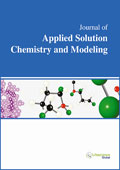jascm
|
|
Abstract: Densities were measured for the binary mixtures of water (methanol or ethanol) and an ionic liquid (IL) 1,3-diethylimidazolium diethylphosphate [EEIM][DEP] or 1-n-butyl-3-ethylimidazolium diethylphosphate [BEIM][DEP] at 1 atm and (293.15 to 333.15) K using a vibrating-tube densimeter. The molecular volume, standard entropy, and lattice energy of the two ILs were estimated with the Glasser theory. The excess volumes are negative for all binary mixtures studied in the whole composition range, and reach to the maximum at the mole fraction of IL being around 0.3. Besides, they decrease with increasing temperature for the aqueous solution of ILs, whilst a reverse trend is found for the IL solutions of methanol or ethanol at any concentration. The excess molar volumes were correlated successfully by a five-parameter polynomial equation as a function of temperature and mole fraction of IL with average absolute relative deviation (ARD) of density within 0.02%. Keywords: Density, excess volume, ionic liquid, water, methanol, ethanol.Download Full Article |
|
|
Abstract: The preferential solvation parameters defined as the differences between the local mole fraction of solvents around analgesic drug acetaminophen and those for the bulk co-solvent composition in propylene glycol + water mixtures were derived from their thermodynamic properties by means of the inverse Kirkwood-Buff integrals (IKBI) and the quasi-lattice-quasi-chemical (QLQC) methods. It is found that acetaminophen is sensitive to solvation effects, so according to IKBI method the preferential solvation parameter δxPG,A, is negative in water-rich mixtures but positive in medium compositions and in co-solvent-rich mixtures. It is conjecturable that in water-rich mixtures the hydrophobic hydration around the aromatic ring and methyl group present in the drug plays a relevant role in the solvation. The bigger drug solvation by co-solvent in mixtures of similar solvent proportions and in propylene glycol-rich mixtures could be due mainly to polarity effects. Otherwise, according to QLQC method, this drug is preferentially solvated by the co-solvent in all the mixtures. Keywords: Acetaminophen, propylene glycol, solubility, inverse Kirkwood-Buff integrals, preferential solvation.Download Full Article |
|
|
Abstract: The solubility of paracetamol in N-Methyl-2-pyrrolidone (NMP) + ethanol and NMP + ethanol + water solvent mixtures at 25 °C was determined using the shake flask method. The generated data extended the solubility database of pharmaceuticals and also was used to assess the solubility prediction capability of the Jouyban-Acree model in NMP + ethanol + water mixtures. The accuracy of the predicted solubilities was evaluated by the mean percentage deviation (MPD) between the predicted and experimental solubilities. The MPD of the Jouyban-Acree model for predicting the solubility of paracetamol in NMP + ethanol + water mixtures at 25 °C was 14.6 %. Keywords: Paracetamol, binary solvents, ternary solvents, solubility prediction, pharmaceutical cosolvents.Download Full Article |
|
|
Abstract: Refractive indices of the binary mixtures containing an isomer of chlorobutane (1-chlorobutane, 2-chlorobutane, 2-methyl-1-chloropropane, or 2-methyl-2-chloropropane) and butyl ethyl ether have been measured at seven temperatures from T = 283.15 to 313.15 K From these data refractive index deviations were calculated and correlated with a Redlich-Kister polynomial expansion. The refractive index deviations were found positive. Finally, from these refractive indices both densities and surface tensions of the studied systems were predicted and compared with previously reported values. Keywords: Butyl ethyl ether, Isomeric chlorobutane, Predicted properties, Refractive index.Download Full Article |
Editor’s Choice : Anisotropic Properties of Mesogenic Surfactants with Ionic Liquid Core
|
|
Abstract: Ionic mesogens (HI-n), constructed from imidazolium-functionalized azobenzenes with differential flexible spacers and a nitro polar terminal group, were synthesized. Their potential thermotropic liquid crystal properties were investigated bypolarizing optical microscopy (POM), differential scanning calorimetry (DSC) and temperature variable X-ray diffraction measurements. HI-n exhibited a smectic A fluid (SmA) phase by anisotropy through interactions between azobenzene units and ionic interactions. This SmA formation was observed by POM and DSC. In the SmA phase, focal conic fan textures were observed by POM under the crossed-Nicols. The perpendicular structure (homeotropic alignment) formed spontaneously in the SmA phase through physical adsorption of imidazolium ionic units upon a glass plate. In the SmA phase, HI-n exhibited the X-ray diffraction patterns consisting of sharp inner reflections, corresponding to the layer distance, and a broad outer reflection exhibiting a short range order within the smectic layer. It is expected that the SmA layer consists of the hydrophilic and hydrophobic sublayers. The hydrophilic sublayer was formed by an ionic aggregation of imidazolium and iodide ions. On the other hand, the hydrophobic sublayer was obtained by segregation from the hydrophilic sublayer. It can be considered that HI-n are an anisotropic ionic liquid because the SmA state has a fluidity such as an ionic liquid. The ionic material shows the strong temperature dependence of an ionic interaction. The ionic interactions in the liquid crystal phase became weak gradually with increasing temperature, and the fluidity of the liquid crystal phase increase. HI-n dissolved in water. The HI-n water solution revealed a lyotropic smectic A anisotropic fluid. Keywords: Anisotropic Fluid, Ionic Liquid Core, Ionic Liquid Crystal, Thermal Property, X-ray diffraction.Download Full Article |


